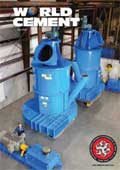Editorial comment
Europe’s most famous biennial exhibition for the quarrying industry, Hillhead 2009, should have taken place this month at Buxton in Derbyshire, UK. Earlier in the year the organisers, reacting to the effects of the global economic situation, decided to postpone the event until 2010.
Register for free »
Get started now for absolutely FREE, no credit card required.
Europe’s most famous biennial exhibition for the quarrying industry, Hillhead 2009, should have taken place this month at Buxton in Derbyshire, UK. Earlier in the year the organisers, reacting to the effects of the global economic situation, decided to postpone the event until 2010. Undaunted by this, we have included a special section on quarrying and quarry restoration in this issue that begins on page 36. Here, readers will find descriptions and case studies from some of the leading international equipment suppliers who specialise in quarry operations.
Extraction of limestone, clay and other materials is essential for the manufacture of cement, but the existence of quarries, so often located in areas of outstanding scenic beauty, near villages or urban communities, has in the past, caused much anger, upset and protest within such communities. But, as Simon Walker points out in 'Natural Solutions' (page 61), “Today, it is no longer acceptable for quarry operators to extract rock – whether it is for road stone, cement production or any other purpose – and then walk away from the site, leaving nature to take its course in terms of landscape restoration.” Walker cites rehabilitation case studies in Germany and in the UK; similar ones can be found in most sustainability reports issued by the major building materials and cement producers. A good example is the landscape greening project at the Juaristi Quarry at Vzcaya (Basque Country) in Spain. Here, Financiera y Minera (Italcementi) is achieving a balance between the correct use of natural resources and long term economic growth. Quarrying and restoration occur simultaneously. The restoration plan is based on reforestation, with the main objective to reproduce the Basque forest. Landscape integration is based on creating survival conditions for implanted and naturally growing vegetation that facilitates reintroduction of local fauna and restores the aesthetic quality of the mined area. The Juaristi quarry’s characteristics are marked by the orography and existing massive rock, which requires a complex mining method (descending benching, blasting and dumping from upper levels), as well as by its close proximity to residential housing, industries and the Urkiola Natural Park.
A fascinating article with a difference, ‘What Lies Beneath…’ (see page 67) describes recent discoveries in the Cemex quarry in Barrington in the UK, which include the remains of an Ichthyosaur, and a large range of fossils. But this month’s issue is not entirely about quarries! With so much talk of the economic crisis and the effects it is having on the worldwide cement industry, it is good to hear of projects in certain countries that have so far remained almost untouched by recent events. One such country is Tunisia, where according to the article from Société des Ciments D’Enfidha (see page 23), large projects such as Enfidha Airport and the Sporting City in Tunis, are creating a steady domestic market. But even here, there are concerns about the effects of excess capacity in the Mediterranean region on the countries of North Africa. This month Elex has a special birthday (see page 31). It is 75 years old and WORLD CEMENT knows how it feels to reach such a milestone, having celebrated the same in 2003, so we say Happy Anniversary!


